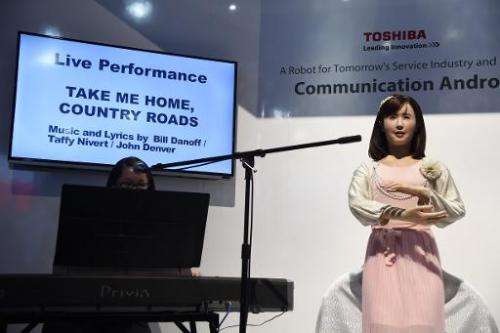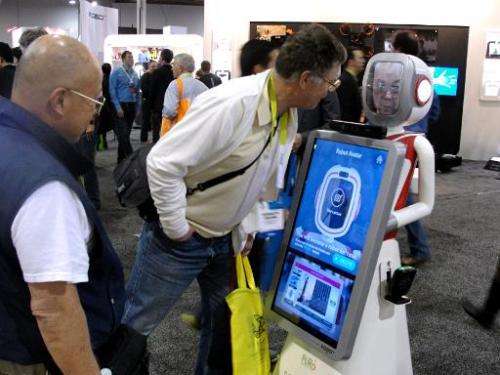The 'human' side of robots at electronics show

She stood on the floor of the Consumer Electronics Show, carried on conversations, blinked her eyes and sang a convincing rendition of "Take Me Home, Country Roads."
It would have been unremarkable if Chihira Aico were not a robot.
"Hello, my name is Chihira Aico. I am 32 years old, although, technically, I was born in September 2014. Look how expressive I am!" she said.
Robots like Toshiba's are becoming so eerily realistic they could be mistaken at first glance for a human. She sings, smiles, raises her hands and has lifelike facial expressions controlled by 15 tiny pneumatic actuators.
These robots are increasingly being developed as personal assistants, companions, hosts and aides for medical situations.
"We made her like a human being because true communication is also based on facial expressions and gestures," said Toshiba's Taihei Yamaguchi.
Yamaguchi said a robot like Chihira Aico could serve as a kind of hostess for the 2020 Olympic Games but the design is aimed for health care, where robots can assist in monitoring and diagnoses.
But in her own words: "In the future, I want to take up the challenge of a wide assignment of tasks: counsellor, newscaster, cheerleader, entertainer and many others!"
The speech was pre-programmed and it will take time to develop the kinds of science fiction robots which can respond to language and move autonomously, Yamaguchi said.
It is possible, as Toshiba showed, to develop robots that look like humans.

But there remains a debate whether robots should be designed as humanoids, like in the film "Blade Runner," or as mechanical ones like in "Star Wars."
Another vision of the robot, "Meccanoid", from the toymaker Spin Master, has a body of polycarbonate Erector set pieces with large lamps for eyes. It too can speak from a pre-programmed text.
South Korean-based Future Robot showed a whimsical wheeled robot that was a cross between a mechanical and human shape, with a face drawn on tablet computer for the head.
"It can move by itself," said Future Robot's Si-Hyeon Kim, who adds that the robot can recognize and speak to a person who approaches.
Such a robot can offer several types of services for business.
"You can customize it, it can do advertising, ticket printing, banking services," he said.
'Not scary'
Some of the other CES robots are being marketed as personal home assistants, like the 70-centimeter (27-inch) hourglass robot Sopo from US-based Optobotics.
"It can bring you a drink," said Kevin Shah, sales and arketing manager for the firm.
"It can drive around by itself without bumping on anything," Shah added.
"Children and pets love it ... thanks to its welcoming feeling, it's not scary."
Some developers say a non-human, playful design is more welcoming.
Jon-Michel Sereda at Five Elements Robotics said the company's Budgee robot—a wheeled cylinder with an oval cartoon-like head on a stick "looks friendly, not too robotic, scary looking or intimidating."
The robot can follow someone and carry things, which can be useful for elderly persons or hospital patients.
"We built it with the idea of helping handicapped people in a wheelchair," he said.
© 2015 AFP





















